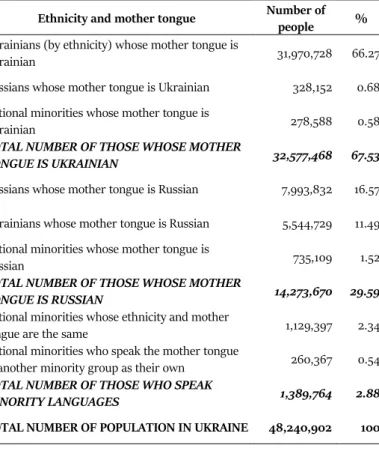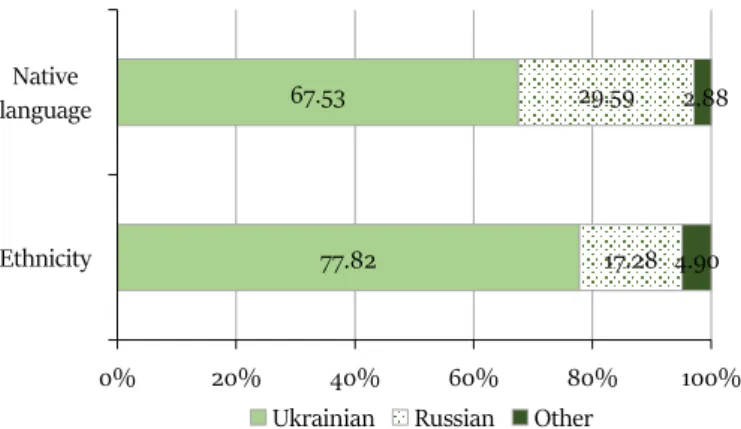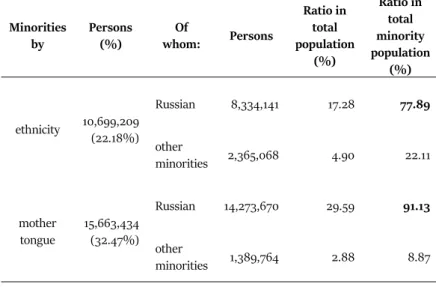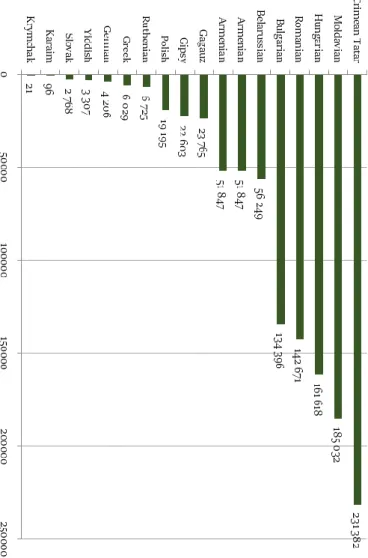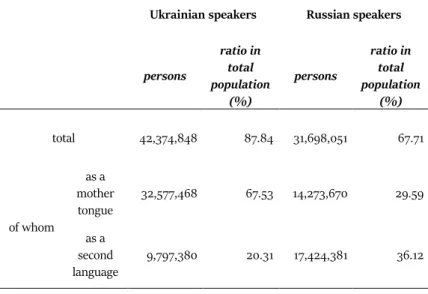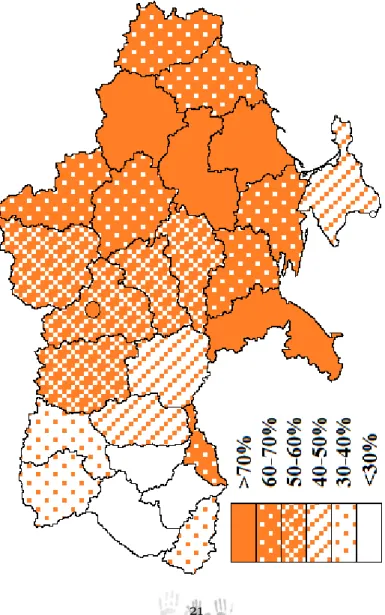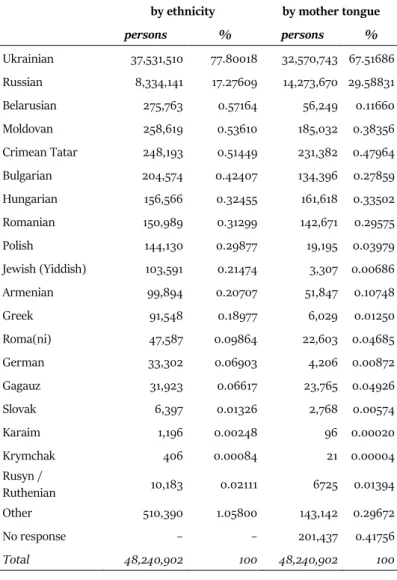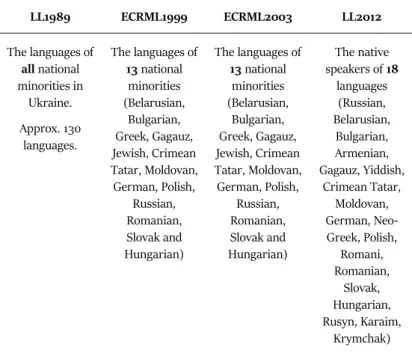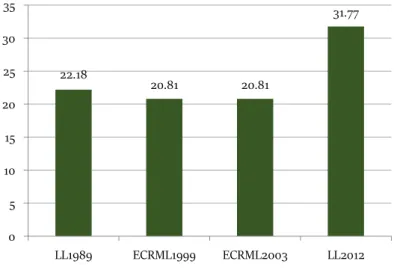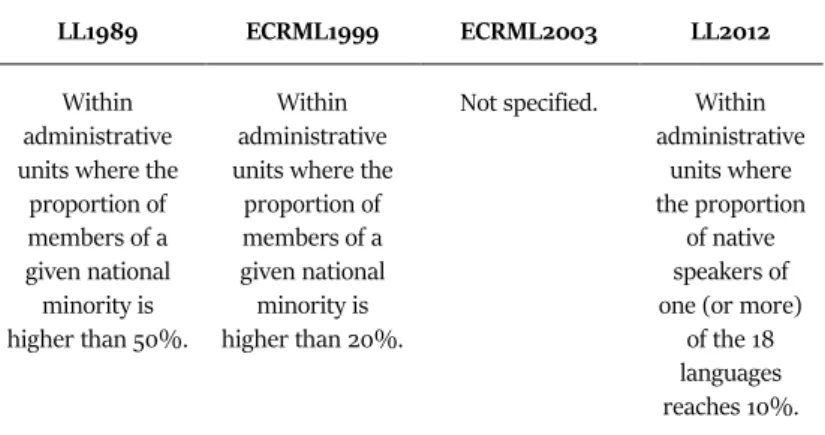On April 25, 2019, the Verkhovna Rada of Ukraine voted in favor of the Law of Ukraine “On Supporting the Functioning of the Ukrainian Language as the State Language”. The law obliges all citizens to use the state language in all spheres of public life. The political elite who governed the state for the years 2014–2019 passed the State Language Law only when they had to pass power after losing the presidential election.
The Law is unable to resolve the social tension that has arisen around the language issue. On the contrary, the law is the source of further conflicts.
This analytical review indicates that the State Language Law
contradicts Ukraine's international obligations. The Law of
Ukraine “On Supporting the Functioning of the Ukrainian
Language as the State Language” is the wrong path of
Ukrainian language policy.
Ukrainian language policy
gone astray
Ukrainian language policy gone astray
The Law of Ukraine “On Supporting the Functioning of the Ukrainian Language as the State Language”
(analytical overview)
István Csernicskó Kornélia Hires-László
Zoltán Karmacsi Anita Márku
Réka Máté Enikő Tóth-Orosz
Foreword:
Petteri Laihonen
2020
ISTVÁN CSERNICSKÓ, KORNÉLIA HIRES-LÁSZLÓ, ZOLTÁN KARMACSI, ANITA MÁRKU,RÉKA MÁTÉ,ENIKŐ TÓTH-OROSZ;PETTERI LAIHONEN (foreword) Ukrainian language policy gone astray: The Law of Ukraine „On Supporting the Functioning of the Ukrainian Language as the State Language” (analytical overview). 2020 – 100 с. (англійською мовою) Науково-інформаційне видання
Верховна Рада України 25 квітня 2019 р. проголосувала за Закон України «Про забезпечення функціонування української мови як державної». Закон зобов’язує використання державної мови у всіх сферах суспільного життя. Політична еліта, яка керувала державою протягом 2014–2019 років ухвалила Закон про державну мову тільки тоді, коли після програшу на президентських виборах їм треба було передати владу. Закон нездатний вирішити суспільну напругу, яка виникла навколо мовного питання. Навпаки: закон є джерелом наступних конфліктів. Цей аналітичний огляд вказує на те, що Закон про державну мову суперечить міжнародним зобов’язанням України.
Закон України «Про забезпечення функціонування української мови як державної» – це помилковий шлях мовної політики України.
ISBN 978-615-80914-5-9
Reviewer:
NOÉMI NAGY, PhD
(National University of Public Service)
Cover-design: ANITA MÁRKU Typographic preparation: ENIKŐ TÓTH-OROSZ
Termini Egyesület Törökbálint, 2020
5
Table of Contents
Foreword (Petteri Laihonen) ... 7
I. Introduction: the linguistic situation in Ukraine ... 11
II. Language laws in Ukraine (1989–2012) ... 24
III. The Law of Ukraine “On Supporting the Functioning of the Ukrainian Language as the State Language” ... 42
Circumstances of the adoption of the law ... 42
The preamble to the law ... 46
The status of the Ukrainian language; State language = official language? ... 48
The use of languages in the public sphere ... 50
The use of languages in education ... 52
The use of languages in the administration of justice ... 64
The use of languages in public administration and public services ... 65
The use of languages in the media ... 70
The use of languages in culture and sport ... 72
Sanctions and penalties ... 75
IV. Ukraine’s international commitments and the State Language Law ... 78
V. Summary and final conclusions ... 95
List of abbreviations ... 97
6
7
Foreword
This summary on language policy in Ukraine, provides a broad view of contemporary developments and their roots. The authors seek to understand recent developments in Ukrainian statehood from a perspective that does not simply reduce the discussion to a case of replacing Russian with Ukrainian. While such a mainstream view has been effective in political campaigns both internally and inter- nationally, the authors outline how the practical manifestations of language policy and the grassroots multilingual reality, with various minorities and regional majorities, paint a different picture.
Among the former Eastern Bloc countries, issues of language policy have been perhaps the most emotionally loaded in Ukraine.
Since the country’s independence in 1991, news stories about fist- fights in the Rada (Parliament) while drawing up language regu- lations, have become familiar around the world. The authors are Hungarian minority researchers in Ukraine. However, they take a comparative and holistic perspective on Ukrainian language policy in general, and provide an explanation of Ukrainian developments from a critical insider’s point of view. The authors have been engaged with Ukrainian language policy since the 1990’s making them the top experts on the topic.
Actuality of the booklet is given by the new (2019) language law in Ukraine “Law on Supporting the Functioning of the Ukrainian Language as the State Language”, which entails a serious curtailing of minority language rights in comparison to earlier policies in the country. Especially alarming is that the new law projects a general diminishing of languages other than Ukrainian as languages of instruction.
My first hand expertise on Ukraine is based on my Academy of Finland postdoctoral project (2011–2013) titled ‘Language ideo- logies among the Hungarian minorities in Slovakia, Romania and
8
Ukraine from a comparative perspective’. This project included a one month fieldwork in Ukraine (see e.g. Csernicskó and Laihonen 2016).
In Ukraine, most Hungarian speakers (totalling 150 000 in Ukraine) live in the Transcarpathian region (Oblast), where they constitute a regional majority in the area next to the Hungarian border. This region has belonged to several states (Hungary, Czechoslovakia, Soviet Union and now Ukraine), where it has always formed a distant periphery in many ways (for details, Csernicskó and Laihonen 2016).
Minority medium schools are cultural and linguistic ‘oases’.
The Hungarian minority in Ukraine constitutes the local majority in villages and towns near to the Hungarian border, and the Hun- garian language has been used as the language of instruction in state run schools in that region throughout history, including the period when it was part of the Soviet Union. The need to have minority medium schools is explained on the one hand on the language repertoire of the children: forcing Hungarian dominant children to be immersed to Ukrainian would lead to ethnolinguistic conflicts, mass migration to Hungary, and under-education of the remaining Hungarian minority for a generation or two. On the other hand, the Hungarian minority regions history as part of the Hun- garian Kingdom and their cultural as well as religious peculiarities have little mention in the Ukrainian national narratives or histories.
That is, the ‘Hungarian’ region presents a historical no-man’s-land or a white spot on the cultural map of Ukraine. As a conclusion to know yourself and to form a positive picture of your past and heritage is possible only through Hungarian medium education. For the learning of the majority, official language of the country, context based, bilingual pedagogies have been developed by Hungarian linguists working in Ukraine. Only mother tongue education and a sophisticated bilingual pedagogy to learn the national language, can promote positive self-identity and belonging both locally and nationally.
9
For Ukraine, minority language communities, such as the Hungarian one, constitute an economic, cultural and linguistic asset.
Their presence elevates the Transcarpathian region as a culturally and linguistically rich touristic destination (see Laihonen and Cser- nicskó 2019). The minority, together with Ukrainians in Hungary, serves as a bridge between the neighbouring countries. To maintain the vitality and numbers of a relatively strong regional linguistic mi- nority, such as Hungarians in Ukraine, requires the right to have the minority language as the language of instruction in all education. As many studies show, the number of minority language speakers still tend to gradually dwindle. What is at stake in Ukraine, is a dangerous move towards an unprecedented and disproportionate forced immersion of minority language dominant children to Ukrainian lan- guage and culture. Such a move is most ill-advised by available applied linguistic knowledge and European legal expertise (see the opinion by Venice Commission) alike and it is clearly against the eco- nomic, cultural and linguistic well being and interests of not just the minorities in Ukraine but also the Ukrainian speaking majority as well.
References
Csernicskó, I. & Laihonen P. 2016. Hybrid Practices meet Nation State Language Policies: Transcarpathia in the 20th Century and Today. Multilingua 36/1: 1–30.
Laihonen, P. & I. Csernicskó 2019. Expanding Marginality: Linguascaping a Transcarpathian spa in south-western Ukraine. S. Kroon & J. Swanenberg (eds.) Language and Culture on the Margins: Global/Local Interactions. Routledge Critical Studies in Multilingualism 16. New York: Routledge, 145–164.
Petteri Laihonen
PhD, Adjunct Professor, Academy Research Fellow Centre for Applied Language Studies University of Jyväskylä, Finland petteri.laihonen@jyu.fi ORCID: 0000-0002-3914-0954
10
11
I. Introduction: the linguistic situation in Ukraine
1. In Ukraine, the language issue is highly politicized. This has been repeatedly pointed out by researchers1 and experts of international organizations2. Paragraph 18 of the opinion of
1 Shumlianskyi, Stanislav: Conflicting abstractions: language groups in language politics in Ukraine. International Journal of the Sociology of Language 201. (2010) 135–161.; Stepanenko, Viktor: Identities and Language Politics in Ukraine: The Challenges of Nation-State Building. In: Farimah Daftary – François Grin (eds.):
Nation-Building Ethnicity and Language Politics in transition countries. Local Government and Public Service Reform Initiative – Open Society Institute, Budapest, 2003. 109–135.; Kulyk, Volodymyr: What is Russian in Ukraine? Pupular Beliefs Regarding the Social Roles of the Language. In: Lara Ryazanova-Clarce (ed.):
The Russian Language Outside the Nation. Edingurgh University Press, Edingurgh, 2014. 117–140.; Pavlenko, Aneta: Multilingualism in Post-Soviet Countries:
Language Revival, Language Removal, and Sociolinguistic Theory. The International Journal of Bilingual Education and Bilingualism 11. (2008) No. 3–4.
275–314.; Ulasiuk, Iryna: The Ukrainian Language: what does the future hold? (A Legal Perspective). In: Antoni Milian-Massana (ed.): Language Law and Legal Challenges in Medium-Sized Language Communities. A Comparative Perspective.
Institut d’Estudis Autonòmics, Barcelona, 2012. 25–51.; Zabrodskaja, Anastassia – Ehala, Martin: Inter-ethnic processes in post-Soviet space: theoretical background.
Journal of Multilingual and Multicurltural Development (2013) DOI:
10.1080/1434632.2013.845194. 1–2.; Шевченко Лариса: Конституційна норма в суспільній дискусії щодо мовних прав в Україні [The Constitutional norm in a public discussion about language rights in Ukraine]. Мовознавство 2013/5: 37–41.
2 Assessment and Recommendations of the OSCE High Commissioner on National Minorities on the Draft Law “On Languages in Ukraine” (No. 1015-3). The Hague, 20 December 2010.
https://iportal.rada.gov.ua/en/news/page/news/News/News/37052.html;
Opinion on the Draft Law on Languages in Ukraine. Adopted by the Venice Commission at its 86th Plenary Session (Venice, 25-26 March 2011).
http://www.venice.coe.int/webforms/documents/?pdf=CDL-AD(2011)008-e;
12
the Venice Commission on the law “On Supporting the Func- tioning of the Ukrainian Language as the State Language” also highlights this fact: “The use of languages has been for a long time in Ukraine a highly sensitive issue, which has repeatedly become one of the main topics in different election campaigns and continues to be a subject of debate – and sometimes to raise tensions – within the Ukrainian society as well as with kin-States of some national minorities of Ukraine.”3
2. The specific features of Ukraine’s geopolitical and geographical situation, its territory inherited from the Soviet Union, the divergent political, historical, economic, cultural and social development of its regions4, the heterogeneous ethnic, linguis- tic and denominational composition of its population5, and the fact that representatives of the titular nation of all the neigh- bouring states are present among its citizens make the linguistic issue a matter of domestic and foreign policy as well as security policy.
3. The relationship between the language issue and security policy is also confirmed by the ongoing armed conflict in the
Ukraine: UN Special Rapporteur urges stronger minority rights guarantees to defuse tensions. Geneva, 16 April 2014.
http://www.ohchr.org/EN/NewsEvents/Pages/DisplayNews.aspx?NewsID=14520.
3 European Commission for Democracy Through Law (Venice Commission).
Ukraine. Opinion on the Law on Supporting the Functioning of the Ukrainian Language as the State Language. CDL-AD(2019)032. Opinion No. 960/2019.
Strasbourg, 9 December 2019.
https://www.venice.coe.int/webforms/documents/?pdf=CDL-AD(2019)032-e.
Hereinafter: Opinion 2019.
4 Karácsonyi, Dávid – Kocsis, Károly – Kovály, Katalin – Molnár, József – Póti, László: East–West dichotomy and political conflict in Ukraine – Was Huntington right? Hungarian Geographical Bulletin 2 (2014): 99–134.
5 Kocsis, Károly – Rudenko, Leonid – Schweitzer, Ferenc eds.: Ukraine in maps.
Kyiv–Budapest: Institute of Geography National Academy of Sciences of Ukraine, Geographical Research Institute Hungarian Academy of Sciences, 2008.
13
country since autumn 2013. Linguistic conflicts have been used as an excuse for the occupation of Crimea and for the outbreak of the armed conflict that continues to devastate the eastern regions of Ukraine, with thousands of deaths. “Today’s si- tuation in Ukraine is an example of how the linguistic and cultural warfare becomes the prerequisite and official basis for a real military campaign”, wrote Drozda, for example.6 “No matter how we look at it, the current Russian–Ukrainian war was started because of the language. This is an indisputable fact. Russia used the language factor as a cause of aggression – with the explanation that it had to protect Russian-speaking citizens in Ukraine” – Osnach summed up the causes of the conflict.7 Sakwa also believes that the language issue was one of the root causes of the conflict in eastern Ukraine.8
4. The Ukrainian state, which became independent in 1991, has been undergoing the deepest crisis of its short history since spring 2014. Ukraine’s mistaken language policy undoubtedly played a role in the eruption of the political, military and economic crisis threatening the security of the whole of Europe and hindering the economic development of the narrower and wider region.
6 Дрозда А. 2014. Розрубати мовний вузол. Скільки російськомовних українців готові наполягати на російськомовності своїх дітей і внуків? [Cut the language knot. How many Russian-speaking Ukrainians are willing to insist on Russian speaking their children and grandchildren?] Портал мовної політики, November 23, 2014. http://language-policy.info/2014/11/rozrubaty- movnyj-vuzol-skilky-rosijskomovnyh-ukrajintsiv-hotovi-napolyahaty-na- rosijskomovnosti-svojih-ditej-i-vnukiv/
7 Оснач С. 2015. Мовна складова гібридної війни [The language component of hybrid warfare]. Портал мовної політики, June 13, 2015. http://language- policy.info/2015/06/serhij-osnach-movna-skladova-hibrydnoji-vijny/
8 Sakwa, Richard: Frontline Ukraine: Crisis in the Borderlands. London: I.B.
Tauris, 2015.
14
5. After the collapse of the Soviet Union, Ukrainian nation- building was greatly facilitated by the federal structure of the communist empire: the Soviet Socialist Republic of Ukraine had (relatively) well-defined external and internal administra- tive boundaries; it had its own government in Kyiv with parlia- ment and ministries; the Republic had its own constitution and codified legal system; there were public administration offices with qualified officials; the administration functioned, in addi- tion to Russian, partly in the Ukrainian language; and Ukraine was represented at the UN. On the other hand – besides the deep economic crisis and the shock caused by the social and political transformation –, the formation of the modern Ukrainian nation was made difficult by the significant Russian community, which overnight became a minority in the sociological sense in the independent Ukraine.9
6. The multi-million community of Russians in Ukraine suddenly became a minority, that is, a group having a de jure subordinate status, whereas it had formerly belonged to the linguistically and culturally privileged group of the Soviet empire. However, de facto, they managed to retain these favourable economic, political and cultural positions to a large extent even after the regime change.
7. In addition to the large number of persons with Russian ethnicity, the position of the Russian language has been strengthened by the millions of Ukrainian citizens who were linguistically assimilated and those who use Russian in their everyday lives. At the time of the 2001 census, the proportion of people belonging to the Russian national minority in the country was 17.28%, whereas the proportion of persons with
9 Brubaker, Rogers: Nationalism Reframed: Nationhood and the National Question in the New Europe. Cambridge: Cambridge University Press, 1996. 17.
15
Russian mother tongue was much higher (Figure 1). The main reason for this is that 5.5 million ethnic Ukrainians declared themselves to be Russian native speakers (Table 1).10
Table 1. The population of Ukraine according to mother tongue and ethnicity (based on 2001 census data)
Ethnicity and mother tongue Number of
people %
Ukrainians (by ethnicity) whose mother tongue is
Ukrainian 31,970,728 66.27
Russians whose mother tongue is Ukrainian 328,152 0.68 National minorities whose mother tongue is
Ukrainian 278,588 0.58
TOTAL NUMBER OF THOSE WHOSE MOTHER
TONGUE IS UKRAINIAN 32,577,468 67.53
Russians whose mother tongue is Russian 7,993,832 16.57 Ukrainians whose mother tongue is Russian 5,544,729 11.49 National minorities whose mother tongue is
Russian 735,109 1.52
TOTAL NUMBER OF THOSE WHOSE MOTHER
TONGUE IS RUSSIAN 14,273,670 29.59
National minorities whose ethnicity and mother
tongue are the same 1,129,397 2.34
National minorities who speak the mother tongue
of another minority group as their own 260,367 0.54 TOTAL NUMBER OF THOSE WHO SPEAK
MINORITY LANGUAGES 1,389,764 2.88
TOTAL NUMBER OF POPULATION IN UKRAINE 48,240,902 100
10 The terms “mother tongue” and “native language” are used interchangeably throughout this paper.
16
Figure 1. The overlap of native language and ethnicity in the population of Ukraine according to the 2001 census (%)
8. Among Ukrainian citizens whose ethnicity or mother tongue is not Ukrainian, ethnic Russians and Russian native speakers are by far the most prominent. In 2001, the proportion of Russians was 77.89% among ethnic minorities of Ukraine and 91.13% among linguistic minorities thereof (Table 2).
9. At the time of the 2001 census, the proportion of ethnic Ukrainians and Russians within the Ukrainian population was 95 percent, and speakers of these two languages together accounted for 97 percent of the total population.
10. From the above data it is clear that the minority issue in Ukraine is almost identical to the issue of the Russian com- munity. Apart from Ukrainians and Russians, the proportion and weight of other ethnic and linguistic groups, including Hungarians, is not significant.
77.82 67.53
17.28 29.59
4.90 2.88
0% 20% 40% 60% 80% 100%
Ethnicity Native language
Ukrainian Russian Other
17
Table 2. Minority citizens by ethnicity and mother tongue in Ukraine (based on 2001 census data)
Minorities by
Persons (%)
Of
whom: Persons
Ratio in total population
(%)
Ratio in total minority population
(%)
ethnicity 10,699,209 (22.18%)
Russian 8,334,141 17.28 77.89
other
minorities 2,365,068 4.90 22.11
mother tongue
15,663,434 (32.47%)
Russian 14,273,670 29.59 91.13
other
minorities 1,389,764 2.88 8.87
11. There are also significant differences in the number of spea- kers of different minority languages. After the Russians, the largest group is the Crimean Tatar speakers, numbering more than 200,000 persons. They are followed by speakers of Mol- dovan, Hungarian, Romanian and Bulgarian. The number of native speakers of other minority languages is less than 100,000 (Figure 2).
18
Figure 2. Native speakers of minority languages in Ukraine, based on 2001 census data (Ruthenian or Rusyn speakers were counted among Ukrainian native speakers)
19
12. Ukraine is characterised by widespread bilingualism.11
“Ukraine is practically a bilingual country where everyone seems to understand both Ukrainian and Russian, and where the vast majority (roughly two-thirds of respondents in various polls) claim they speak both languages fluently” – Rjabcsuk summarizes the situation.12
13. According to the 2001 census, 56.84% of the Ukrainian popu- lation speak “fluently” at least one language other than their mother tongue. This proportion was 63.23% among the urban population and 43.92% among the rural population.13 Because the data included language skills for infants and elderly people, Lozyns’kyi estimates that 80% of the adult population can speak fluently (at least) one language in addition to their mother tongue.14
14. In 2001, 87.84% of the country’s population spoke Ukrainian and 67.71% spoke Russian (Table 3). According to the census data, 58.76% of Russians had a good command of the
11 Besters-Dilger, Juliane (ed.): Language policy and language situation in Ukraine:
Analysis and recommendations. Peter Lang, Frankfurt am Main, 2009.; Bowring, Bill: The Russian Language in Ukraine: Complicit in Genocide, or Victim of State- building? In: Lara Ryazanova-Clarce (ed.): The Russian Language Outside the Nation. Edingurgh University Press, Edingurgh, 2014. 56–78.; Bilaniuk, Laada:
Language in the balance: the politics of non-accommodation on bilingual Ukrainian–Russian television shows. International Journal of the Sociology of Language 210 (2010): 105–133.; Майборода Олександр та ін. (ред.): Мовна ситуація в Україні: між конфліктом і консенсусом [The Language Situation in Ukraine: Between Conflict and Consensus]. Інститут політичних і етнонаціональних досліджень імені І. Ф. Кураса НАН України, Київ, 2008.
12 Rjabcsuk, Mikola: A két Ukrajna [Two Ukraines]. Örökség Kultúrpolitikai Intézet, Budapest, 2015. 136.
13 Лозинський Роман: Мовна ситуація в Україні (суспільно-географічний погляд) [Linguistic situation in Ukraine: a socio-geographical view]. Видавничий центр ЛНУ імені Івана Франка, Львів, 2008. 246.
14 Лозинський 2008: 254.
20
Ukrainian language, and 58.07% of Ukrainians had a good command of Russian.15
Table 3. Number and proportion of persons speaking Ukrainian and Russian “freely” in Ukraine, based on 2001 census data16
Ukrainian speakers Russian speakers
persons
ratio in total population
(%)
persons
ratio in total population
(%)
total 42,374,848 87.84 31,698,051 67.71
of whom
as a mother
tongue
32,577,468 67.53 14,273,670 29.59
as a second language
9,797,380 20.31 17,424,381 36.12
15. The proportion of bilinguals was much higher in the eastern (mainly Russian-populated) areas of the country than in the (mostly Ukrainian) western parts (Figure 3).
15 Лозинський 2008: 216.
16 Лозинський 2008: 199–200., 214–215.
21
Figure 3. Proportion of persons who speak (at least) one language
“freely” in addition to their mother tongue, according to 2011 census data (Based on Lozyns’kyi 2008: 246.)
22
16. Sociological and sociolinguistic research also confirms the widespread use of bilingualism. In certain parts of the country and in many situations (such as in pop culture) the Russian language is dominant.
17. The nature of bilingualism in Ukraine is primarily due to histo- rical factors, such as that during the existence of the Soviet Union, the Russian language received stronger support in Soviet Ukraine than Ukrainian and other languages.
18. In the last days of the Soviet Union and after the fall of the empire, both among the Ukrainians and among the Roma- nians, Hungarians, Poles, etc. there was a growing interest in their own culture and language, and there appeared demands for extending the use of their own language as opposed to the previously privileged position of the Russian language. During this period and in the early years of Ukrainian sovereignty, the respective goals of the majority nation (the Ukrainians) and those of the minorities living in the country coincided.
However, while the situation of the Ukrainian majority and that of the minorities in the Soviet Union had been similar in many respects, after 1991 their parallel efforts to strengthen the position of their languages has come into conflict: the language policy of the Ukrainian state insists that the functions previously enjoyed by the Russian language be taken over by the Ukrainian language, whereas national minorities also want to use their mother tongues in as many spheres of language use as possible.
19. As a result, after Ukraine’s independence, the linguistic situa- tion has created conflicts in an already troubled transitional situation, full of political and economic crises. These conflicts are still not fully resolved. The conflict stems from the fact that the state-organizing ethnic group (the Ukrainian) seeks to play an exclusive role in the public, symbolic space of languages.
23
20. The conflict is exacerbated by that Ukraine’s language policy considers strengthening the position of the Ukrainian lan- guage as one of its most important goals.
21. The language policy of impatient Ukrainianisation, which has longed for revenge for historical insults, is being pushed by the Ukrainian political elite despite the fact that since spring 2014 the country’s population has become much more homogenous both ethnically and linguistically. One reason for this is that a large part of the Donetsk and Luhansk districts of eastern Ukraine, uncontrolled by Kyiv, and the Crimean peninsula, annexed by Russia in contravention of international law, have significant ethnic Russian and Russian-speaking populations.
A substantial part of the Crimean Tatars also remained in the Moscow-controlled Crimea. As a result, the weight of the clearly Ukrainian dominated western territories has increased significantly in the country.
22. The wartime situation and the loss of control over some areas have greatly strengthened patriotic sentiment and national pride, at the same time impatient nationalism has also been gaining ground.
23. Central language policy should strike a balance between pro- moting the State language and protecting minority languages in this complex situation. However, as shown below, the Law of Ukraine on Supporting the Functioning of the Ukrainian Language as the State Language (hereinafter: SLL2019), passed by the Supreme Council (Parliament) of Ukraine on 25 April 2019, is not capable of strengthening social consensus, nor promoting social reconciliation, and thus cannot create a delicate balance.
24
II. Language laws in Ukraine
24. In Ukraine, which became independent in 1991, four laws were adopted until spring 2019 with the central aim of regulating the language regime. These laws are: (1) Law of Ukraine “On Languages in the Ukrainian SSR” (LL1989)17; (2) Law of Ukraine “On Ratification of the European Charter for Regional or Minority Languages, 1992”18 (ECRML1999); (3) Law of Ukraine “On Ratification of the European Charter for Regional or Minority Languages”19 (ECRML2003); (4) Law of Ukraine
“On the Principles of State Language Policy” (LL2012).20 25. The 1989 Language Law (LL1989), adopted before the inde-
pendence, was a compromise between Ukrainianisation and the maintenance of the existing status quo.21 According to analysts,22 the law equally promoted Ukrainian nation- building and the continued presence of the Russian language
17 Закон України «Про мови в Українській РСР» [Law of Ukraine "On Languages in the Ukrainian SSR"]. http://zakon4.rada.gov.ua/laws/show/8312- 11 (LL1989)
18Закон України «Про ратифікацію Європейської хартії регіональних мов або мов меншин, 1992 р.» [Law of Ukraine “On Ratification of the European Charter for Regional or Minority Languages, 1992”].
https://zakon.rada.gov.ua/laws/show/1350-14. Hereinafter: ECRML1999.
19 Закон України «Про ратифікацію європейської хартії регіональних мов або мов меншин» [Law of Ukraine “On Ratification of the European Charter for Regional or Minority Languages”]. http://zakon4.rada.gov.ua/laws/show/802-15.
Hereinafter: ECRML2003.
20 Закон України «Про засади державної мовної політики» [Law of Ukraine
"On the Principles of State Language Policy"].
https://zakon.rada.gov.ua/go/5029-17. Hereinafter: LL2012.
21 Arel, Dominique: Language politics in independent Ukraine: Towards one or two state languages? Nationalities Papers 23(1995)/3: 597–622.
22 Kulyk, Voldymyr: Constructing common sense: Language and ethnicity in Ukrainian public discourse. Ethnic and Racial Studies 29(2006)/2: 281–314.
25
in many areas of life. Others23 interpret the law as a compro- mise which, on the one hand, codified the status of the Ukrainian State language and, on the other hand, preserved the privileged position of the Russian language in many spheres of social and public life. There also exists an assess- ment according to which LL1989 was the first legal step towards the de-Sovietization and independence of the country in 1991.24
26. Ukraine, an independent state since 1991, was required by Opinion No 190 (1995) of the Parliamentary Assembly of the Council of Europe25 as a condition for membership of the Council of Europe to ratify the Framework Convention for the Protection of National Minorities (hereinafter: “the Frame- work Convention”), and to sign and ratify, within one year of its accession to the Council of Europe, the European Charter for Regional or Minority Languages (hereinafter referred to as
“the Charter”).
27. Accordingly, the Supreme Council of Ukraine ratified the Framework Convention in 199726 and the Charter in 1999.27 However, the law on the ratification of the Charter
23 Котигоренко Віктор: Етнічні протиріччя і конфлікти в сучасній Україні:
політологічний концепт [Ethnic Contradictions and Conflicts in Modern Ukraine: A Concept of Political Science]. Київ, 2004. 518–519.
24 Bilaniuk, Laada: Gender, Language Attitudes, and Language Status in Ukraine.
Language in Society 32 (2003): 47–78.
25 PACE Opinion 190, 26/9/95. Application by Ukraine for membership of the Council of Europe. Para. 12.7. https://assembly.coe.int/nw/xml/XRef/Xref- XML2HTML-en.asp?fileid=13929&lang=en
26Закон України «Про ратифікацію Рамкової конвенції Ради Європи про захист національних меншин» [Law of Ukraine “On Ratification of the Council of Europe’s Framework Convention for the Protection of National Minorities”].
https://zakon.rada.gov.ua/laws/show/703/97-%D0%B2%D1%80
27 ECRML1999
26
(ECRML1999) was repealed by the Constitutional Court of Ukraine in 2000 for formal reasons.28 According to analysts, Kyiv’s political intention was for Ukraine to comply with its international obligations and formally ratify the Charter, but it never wanted the international instrument to enter into force, so that it would not have to implement its obligations undertaken by the ratification.29
28. In 2003, Ukraine ratified the Charter again (ECRML2003).30 However, the instrument of ratification was deposited with the Secretary General of the Council of Europe only two years later, on 19 September 2005. The Charter entered into force in Ukraine as late as 1 January 2006.
29. The ratification of the Charter was preceded and followed by strong negative propaganda in Ukraine. Politicians, State officials, academics, activists, and journalists have criticized the Charter. During this negative campaign, several false claims were made about the Charter. This has significantly undermined the prestige of the Charter among the population of the country.
28 Рішення Конституційного Суду України у справі за конституційним поданням 54 народних депутатів України щодо відповідності Конституції України (конституційності) Закону України «Про ратифікацію Європейської хартії регіональних мов або мов меншин 1992 р.» від 12.07.2000 р. № 9- рп/2000. [Decision of the Constitutional Court of Ukraine in the case on the constitutional petition of 54 People’s Deputies of Ukraine on compliance with the Constitution of Ukraine (constitutionality) of the Law of Ukraine "On Ratification of the European Charter for Regional or Minority Languages of 1992" of 12.07.2000 No. 9-rp/2000.] https://zakon.rada.gov.ua/laws/show/v009p710-00.
Hereinafter: Constitutional Court 2000.
29 Bowring, Bill – Antonovych, Miroslava: Ukraine’s long and winding road to the European Charter for Regional and Minority Languages, In: The European Charter for Regional or Minority Languages: Legal Challenges and Opportunities, Council of Europe Publishing, Strasbourg, 2008, 157–182.
30 ECRML2003.
27
30. On 3 July 2012, after lengthy debates and under scandalous circumstances, the Kyiv Parliament passed a new language law (LL2012) to replace the former one (LL1989). The text of the law was published in the official gazette Голос України [Voice of Ukraine] on 10 August 2012, and thus LL2012 entered into force.31 The law continued to be in the crossfire of disputes.
31. There have been several attempts to declare the law unconsti- tutional. A petition submitted by 51 People’s Deputies in 2012 was rejected by Decision 10-у/2013 of the Constitutional Court of Ukraine on 27 March 2013.32 On 7 July 2014, 57 People’s Deputies referred the matter to the Constitutional Court once more.33 However, the Constitutional Court started to deal with the petition only years later. The law was finally annulled by the Constitutional Court of Ukraine (due to formal reasons) on 28 February 2018.34
31 LL2012.
32 Ухвала Конституційного Суду України про відмову у відкритті конституційного провадження у справі за конституційним поданням 51 народного депутата України щодо відповідності Конституції України (конституційності) Закону України «Про засади державної мовної політики» від 27. 03. 2013 р. № 10-у/2013. [Decision of the Constitutional Court of Ukraine on refusal to open constitutional proceedings in the case of the constitutional petition of 51 People's Deputies of Ukraine on compliance with the Constitution of Ukraine (constitutionality) of the Law of Ukraine "On Principles of the State Language Policy" of March 27, 2013, No. 10-y/2013.]
http://zakon4.rada.gov.ua/laws/show/v010u710-13
33 http://ccu.gov.ua/doccatalog/document?id=252116
34 Рішення Конституційного Суду України у справі за конституційним поданням 57 народних депутатів України щодо відповідності Конституції України (конституційності) Закону України «Про засади державної мовної політики» від 28. 02. 2018 р. № 2-р/2018. [Decision of the Constitutional Court of Ukraine in the case of the constitutional petition of 57 People’s Deputies of Ukraine on compliance with the Constitution of Ukraine (constitutionality) of the Law of Ukraine "On Principles of the State Language Policy" of February 28, 2018,
28
32. LL2012 was annulled by the Constitutional Court on the ground that the constitutional procedure for debating and adopting laws in Parliament had been violated. The Constitu- tional Court made no criticism as regards the content of LL2012.
33. LL1989, ECRML1999 and ECRML2003 apply to the languages of the national minorities in the country. In contrast, LL2012 defines the rights of native speakers of regulated languages.
The distinction is important. In fact, there is a significant difference in the composition of Ukraine’s population in terms of ethnicity as opposed to mother tongue. As can be seen from Table 4, during the 2001 census much more people declared themselves to be ethnic Ukrainians than to have Ukrainian as their mother tongue. Therefore, the number and proportion of people belonging to national minorities is significantly lower than the number of members of linguistic minorities.
34. LL1989 protects the languages of all national minorities in Ukraine, totalling almost 130 languages. According to the 2001 census, more than 130 nationalities and ethnicities live in the country.35 Although the Charter applies to regional or minority languages, the scope of the Ukrainian ratification laws of the international document (ECRML1999 and ECRML2003) extends to the languages of 13 national minorities in Ukraine.
In turn, LL2012 safeguards the rights of native speakers of 18 Ukrainian minority languages (Table 5).
No. 2-p/2018.] https://zakon.rada.gov.ua/laws/show/v002p710-18. Hereinafter:
Constitutional Court 2018.
35 Kuras, Ivan F. – Pirozhkov, Serhyi I. eds.: First All-National Population Census:
historical, methodological, social, economic, ethnic aspects. Kyiv: State Statistic Committee of Ukraine and Institute for Demography and Social Studies, 2004. 99.
29
Table 4. Population of Ukraine by ethnicity and mother tongue (2001 census)36
by ethnicity by mother tongue
persons % persons %
Ukrainian 37,531,510 77.80018 32,570,743 67.51686 Russian 8,334,141 17.27609 14,273,670 29.58831
Belarusian 275,763 0.57164 56,249 0.11660
Moldovan 258,619 0.53610 185,032 0.38356
Crimean Tatar 248,193 0.51449 231,382 0.47964
Bulgarian 204,574 0.42407 134,396 0.27859
Hungarian 156,566 0.32455 161,618 0.33502
Romanian 150,989 0.31299 142,671 0.29575
Polish 144,130 0.29877 19,195 0.03979
Jewish (Yiddish) 103,591 0.21474 3,307 0.00686
Armenian 99,894 0.20707 51,847 0.10748
Greek 91,548 0.18977 6,029 0.01250
Roma(ni) 47,587 0.09864 22,603 0.04685
German 33,302 0.06903 4,206 0.00872
Gagauz 31,923 0.06617 23,765 0.04926
Slovak 6,397 0.01326 2,768 0.00574
Karaim 1,196 0.00248 96 0.00020
Krymchak 406 0.00084 21 0.00004
Rusyn /
Ruthenian 10,183 0.02111 6725 0.01394
Other 510,390 1.05800 143,142 0.29672
No response – – 201,437 0.41756
Total 48,240,902 100 48,240,902 100
36 Source: http://2001.ukrcensus.gov.ua/results/general/nationality/
30
Table 5. Languages covered by the four laws
LL1989 ECRML1999 ECRML2003 LL2012
The languages of all national minorities in
Ukraine.
Approx. 130 languages.
The languages of 13 national
minorities (Belarusian,
Bulgarian, Greek, Gagauz, Jewish, Crimean Tatar, Moldovan, German, Polish,
Russian, Romanian, Slovak and Hungarian)
The languages of 13 national
minorities (Belarusian,
Bulgarian, Greek, Gagauz, Jewish, Crimean Tatar, Moldovan, German, Polish,
Russian, Romanian, Slovak and Hungarian)
The native speakers of 18
languages (Russian, Belarusian,
Bulgarian, Armenian, Gagauz, Yiddish,
Crimean Tatar, Moldovan, German, Neo- Greek, Polish, Romani, Romanian,
Slovak, Hungarian, Rusyn, Karaim,
Krymchak)
35. LL1989 affects 22.18 percent of the country’s population. The scope of ECRML1999 and ECRML2013 extends to 20.81 percent of Ukraine’s population. LL2012 applies to nearly one third (31.77%) of the population (Figure 4).
36. Under certain conditions, all four laws allow minority lan- guages to appear in the public sphere, usually alongside the State language. Most of the legislation analysed set a demographic threshold for the use of minority languages in official situations (Table 6).
31
Figure 4. Proportions of the country’s population affected by the four laws
37. LL1989 allows for the use of the languages of national minori- ties in public offices if the members of the respective national minority constitute an absolute majority within the borders of the administrative unit. The demographic threshold for using a minority language is therefore very high: 50%. Even so, the use of the minority language is not obligatory, it is only an option.
38. ECRML1999 provides for the use of national minority lan- guages in public offices where the proportion of persons be- longing to the given national minority exceeds 20 percent.
39. ECRML2003 does not define a demographic threshold, instead it states that the use of regional or minority languages is permitted in the areas of those regional or local governments
22.18
20.81 20.81
31.77
0 5 10 15 20 25 30 35
LL1989 ECRML1999 ECRML2003 LL2012
32
where the number of users of regional or minority languages justifies this.
40. Pursuant to LL2012, regional or minority languages can be used in public offices and local governments if the proportion of their native speakers reaches 10% in the territory of the given administrative unit. In such cases, the law obligatorily prescribes the use of minority languages in oral and written communications. Local governments shall also publish their resolutions in the respective minority language, in addition to Ukrainian (Table 6).
Table 6. Demographic thresholds for the use of minority languages in Ukraine
LL1989 ECRML1999 ECRML2003 LL2012
Within administrative units where the proportion of members of a given national minority is higher than 50%.
Within administrative units where the proportion of members of a given national minority is higher than 20%.
Not specified. Within administrative
units where the proportion
of native speakers of one (or more)
of the 18 languages reaches 10%.
41. LL1989, LL2012 and ECRML1999 determine that minority languages can be used in administrative units at the regional (область), district (район) and municipal (city, town and village) levels. The ECRML2003 does not specify the types of administrative areas in which regional or minority languages can be used (Table 7).
33
Table 7. Administrative levels covered by the four laws
LL1989 ECRML1999 ECRML2003 LL2012
Region, district, municipality.
Administrative unit (region, district,
municipality)
Not specified. Region, district, municipality.
42. LL2012, in accordance with the first paragraph of Article 10 of the Constitution of Ukraine, designated Ukrainian as the only State language.
43. According to the official interpretation of the above article of the Constitution by the Constitutional Court,37 the State lan- guage (державна мова) is also an official language (офіційна мова) in Ukraine. However, pursuant to the opinion of the Constitutional Court, the fact that the country has only one State language does not mean that only Ukrainian can be used as an official language. Accordingly, LL2012 allows for the official use of minority languages under certain conditions.
37 Рішення Конституційного Суду України у справі за конституційним поданням 51 народних депутатів України про офіційне тлумачення положень статті 10 Конституції України щодо застосування державної мови органами державної влади, органами місцевого самоврядування та вико- ристання її у навчальному процесі в навчальних закладах України (справа про застосування української мови) від 14. 12. 1999 р. № 10-рп/99. [Decision of the Constitutional Court of Ukraine on the constitutional petition of 51 People’s Deputies of Ukraine on the official interpretation of Article 10 of the Constitution of Ukraine on the use of the State language by State authorities, local self- government bodies and in the educational process in educational establishments of Ukraine (the case on the use of the Ukrainian language) of December 14, 1999, No. 10-pr/99.] http://zakon4.rada.gov.ua/laws/show/v010p710-99. Hereinafter:
Constitutional Court 1999.
34
44. Under LL2012, certain rights were required to be granted obligatorily and automatically by local authorities in those administrative units where the proportion of native speakers of one (or more) of the 18 languages listed in the law reached 10%. Such rights included, for example, the official publication of documents of local State and municipal authorities in minority or regional languages; public officials had to use mi- nority languages in their communications with persons speak- ing minority languages; written submissions in a regional language had to be answered in the same language; minority languages had to be taught in school education; geographical names had to be displayed in minority languages, too.
45. Although the proportion of Russian native speakers in the country was 29.5% at the time of the 2001 census, the appli- cation of LL2012 was only required at the regional, district and municipality levels. Consequently, in spite of the fact that the proportion of Russian native speakers in Ukraine is significantly above 10%, only one State and official language remained at the national level after the adoption of LL2012:
Ukrainian.
46. At the macro level, therefore, LL2012 did not introduce official bilingualism: Ukrainian remained the only State language of Ukraine, and Russian did not even become a second official language at the national level.
47. LL2012 allowed for the use of regional or minority languages – both orally and in writing, in private and public life – in the territory of those regions (область), districts (район) and municipalities where, according to official census data, the proportion of native speakers of the respective language met the 10 % threshold.
35
48. At the time of the 2001 census, Ukraine was divided into 27 administrative units (24 regions, the capital of Kyiv, the Autonomous Republic of Crimea, and the capital thereof, Sevastopol). In 11 of the 24 regions (область), the proportion of Russian native speakers exceeded 10%. In addition, the proportion of Russian-speakers was higher than 10% in Kyiv and Sevastopol. In the Autonomous Republic of Crimea, both Russian and Crimean Tatar native speakers counted more than 10%. In Chernivtsi region, Romanian speakers met the 10% threshold. The proportion of Hungarian native speakers in Transcarpathia was almost 13%. Thus, at the highest administrative level, the Russian, Hungarian, Romanian and Crimean Tatar languages could be used alongside the State language under LL2012 (Figure 5).
49. If we take not only the regional level, but also the level of districts (район) and cities of regional significance (місто обласного значення), and examine which languages had enough speakers there to reach the 10% threshold required for the enforcement of linguistic rights, we can see that the proportion of Russian native speakers was at least one tenth of the population in many districts and cities (Figure 6).
50. In addition to Russian, in some districts, native speakers of Bulgarian, Gagauz, Crimean Tatar, Hungarian, Romanian and Moldovan have also reached the demographic thresholds set by LL2012. Bulgarian, Crimean Tatar, Gagauz, Moldovan and Romanian native speakers reached 10% in 7, 15, 1, 8 and 7 districts, respectively. Hungarian native speakers made up at least one-tenth of the population in four districts and one city of district significance (Figure 7).
36
Figure 5. Regional or minority languages in Ukraine at the regional level, based on 2001 official census data
37
Figure 6. Districts and cities of district significance where Russian native speakers reach the 10% threshold (based on 2001 census data)
38
Figure 7. Districts and cities of district significance where the proportion of native speakers of certain regional or minority languages reaches the 10% threshold (based on 2001 census data)
39
51. According to the latest (2001) census in Ukraine, the pro- portion of Hungarian native speakers in Transcarpathia was 12.65%. The proportion of Hungarian native speakers reached the 10% threshold in the Berehove district (80.2%), the Vynohradiv district (26.0%), the Mukachevo district (13.8%), and the Uzhhorod district (36.5 %), furthermore, in four cities (Berehove / Берегове / Beregszász, Chop / Чоп / Csap, Vy- nohradiv / Виноградів / Nagyszőlős, Tyachiv / Тячів / Técső) and 69 rural municipalities. The proportion of Romanian native speakers met the 10% threshold in the Tiachiv / Тячів / Técső and Rakhiv / Рахів / Rahó districts and in seven mu- nicipalities. Slovak native speakers achieved 10% in one muni- cipality (Storozhnytsia / Строжниця / Őrdarma), German native speakers in two municipalities (Shenborn / Шенборн / Schönborn, Pavshyno / Павшино / Paushing). The proportion of Roma native speakers reached 10% in Seredne / Середнє / Szerednye, whereas Rusyn native speakers composed more than 10% of the population in Hankovytsia / Ганьковиня and Nelipyno / Неліпино municipalities (Figure 8).
52. It can be seen from the above that LL2012 created favorable conditions for the use of the Russian language, but other minority languages also became available at the regional (Hungarian, Romanian, Crimean Tatar) and/or district (Hungarian, Romanian, Moldovan, Gagauz, Bulgarian, Crimean Tatar) levels, whereas at the municipal level the official use of many other languages (e. g. Slovak, German, etc.) was allowed by the law.
53. However, as mentioned before, LL2012 was repealed by the Constitutional Court of Ukraine in 2018.38
38 Constitutional Court 2018.
40
Figure 8. Municipalities in Transcarpathia where the proportion of speakers of one (or more) regional or minority languages reaches 10 percent, according to 2001 official census data
41
54. At the ratification of the Charter, under Article 9 (3), Ukraine undertook to make available in regional or minority languages the most important legal texts of the State and those which are of particular interest to the users of these languages. The last law the Kyiv government made available in minority lan- guages was LL1989. Official translations of ECRML2003, LL2012 and SLL2019 have still not been produced in regional or minority languages, despite the fact that these legal instru- ments directly affect the rights of minority language users.
42
III. The Law of Ukraine “On Supporting the Functioning of the Ukrainian Language as the State Language”
Circumstances of the adoption of the law
55. The Supreme Council of Ukraine passed the new law on the State language on 25 April 201939 (hereinafter: SLL2019).
56. On 15 May 15 2019, President Petro Poroshenko signed the law, and SLL2019 entered into force on 16 July 2019.
57. The parliamentary voting and the signing of the law by the President (which were necessary conditions for the law to enter into force) took place after the second round of the Ukrainian presidential election. In the first round of the presi- dential election, held on 31 March 2019, President Poroshenko, who had been in power since 2014, took second place with 15.95 percent of the votes, behind Volodymyr Zelensky, who gained 30.24 percent. In the second round of April 21, Poroshenko suffered a massive defeat: against the backdrop of a 62.07 percent participation rate, he garnered only 24.46 percent of the ballots, while Zelensky gained 73.23 percent.
The Kyiv parliament therefore adopted the law on the State language when it was already clear that a new political era was to begin in Ukraine.
39 Закон України «Про забезпечення функціонування української мови як державної». [Law of Ukraine “On Supporting the Functioning of the Ukrainian Language as the State Language”.] https://zakon.rada.gov.ua/laws/show/2704-19.
Non-official translation of the law is available here:
https://www.venice.coe.int/webforms/documents/?pdf=CDL-REF(2019)036-e (SLL2019). Excerpts from SLL2019 in this paper are given based on this document.
